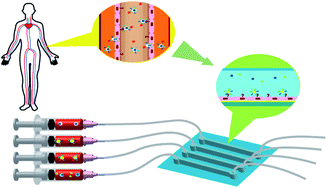Leukocyte adhesion to the endothelium through surface molecules such as E-selectin and intercellular adhesion molecule-1 (ICAM-1) is a critical cellular event reflecting the physiological status of both cell types. Here we present a microfluidic system that can not only easily monitor the interaction between leukocytes and endothelial cells under physiological conditions, but also screen drug candidates for potential modulation of this interaction. Shear stress, which is an important factor for the binding of activated T cells to tumor necrosis factor-alpha (TNF-α)-treated human umbilical vein endothelial cells (HUVECs), was easily controlled by adjusting the flow rate in the microfluidic system. Whole blood of patients with systemic lupus erythematosus (SLE) who have auto-reactive T cells were infused into the activated HUVECs which subsequently showed a higher level of binding compared to a control blood sample from a person without SLE. When these autoreactive T cells were treated with immunosuppressors tacrolimus and cyclosporin A, the binding of the T cells to HUVECs was dramatically decreased. Therefore, this microfluidic system is capable of differentiating the physiological status of T cells or endothelial cells representing different disease conditions, as well as being useful for the identification of novel reagents that modulate the functions of leukocytes or endothelial cells.

You have access to this article
 Please wait while we load your content...
Something went wrong. Try again?
Please wait while we load your content...
Something went wrong. Try again?


 Please wait while we load your content...
Please wait while we load your content...